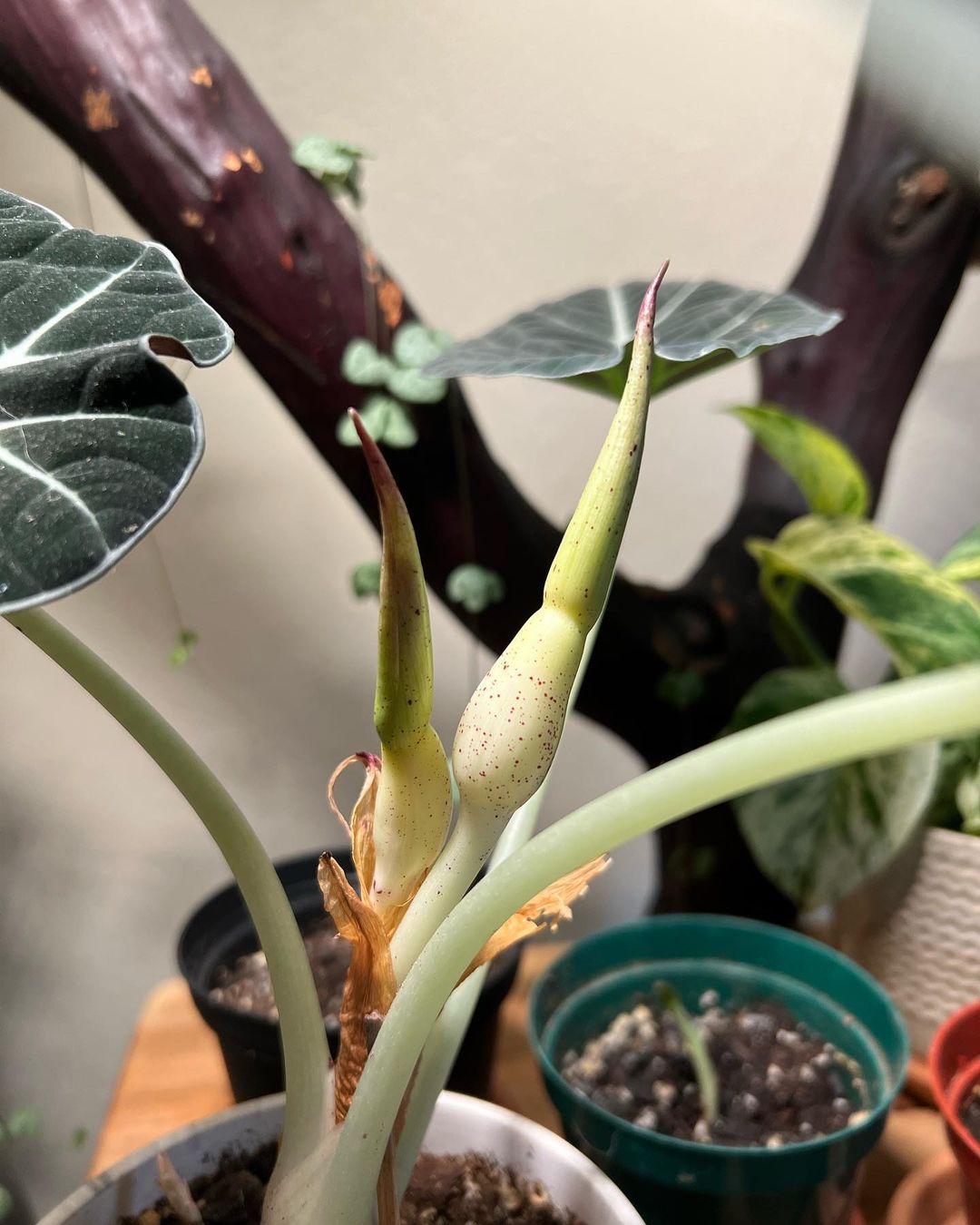The Alocasia Black Velvet Flower, a stunning addition to any houseplant collection, is revered for its unique charm and sophisticated elegance.
Thus, delve deeper to understand the flowering dynamics of Alocasia Black Velvet and care tips to encourage flowering indoors.
Table of Contents Show
Unveiling the Alocasia Black Velvet Flower
Alocasia Black Velvet is a tropical-perennial houseplant known for its dramatic foliage.
However, the plant’s standout feature is its flower—a captivating spectacle that adds an extra layer of charm to the already impressive plant.
This flower is not your typical eye-catching bloom; it’s a subtle and sophisticated floral structure that reflects the plant’s overall aura of elegance.
The bloom, technically termed an inflorescence, is a composite of several tiny flowers arranged on a spadix, enveloped by a leaf-like bract or spathe.
The flowers are usually pale yellow to white, contrasting beautifully with the plant’s dark foliage.
The Blooming Cycle of Alocasia Black Velvet
The blooming cycle of the Alocasia Black Velvet is somewhat unpredictable. Unlike other houseplants, it doesn’t have a fixed season for flowering.
However, the plant typically blooms during spring and summer if the conditions are idle.
The plant’s age plays a significant role in its ability to flower. Alocasia Black Velvet plants usually take about two to four years to mature to a stage where they can produce flowers.
However, even mature plants don’t guarantee a flower. The plant must be content with its growing conditions to initiate blooming.
The Enigma of Alocasia Black Velvet’s Flowering Indoors
While the Alocasia Black Velvet flourishes and flowers abundantly in its natural habitat, achieving the same success indoors is a different story.
Indoor flowering is a challenging feat, requiring gardeners to replicate the plant’s natural growing conditions as closely as possible.
Although indoor blooming is rare, it isn’t impossible. A well-tended Alocasia Black Velvet can surprise indoor gardeners with its delicate flowers.
Remember that indoor flowering is a sign of a happy and healthy plant.
Decoding the Alocasia Black Velvet Flower Structure
The Alocasia Black Velvet flower is an unconventional beauty.
It lacks the showy petals found in typical flowers; instead, it consists of a cylindrical spadix packed with tiny flowers—encased by a leaf-like bract or spathe.
The flowers are generally white or pale yellow, offering a striking contrast against the plant’s dark green or purple-speckled foliage.

Although small and understated, the flower is a fascinating plant life cycle aspect. The inflorescence comprises numerous tiny male and female flowers.
The male flowers occupy the upper part of the spadix, while the female flowers are in the lower region. This unique arrangement fosters cross-pollination, ensuring the plant’s survival and propagation.
Pollination Peculiarities of Alocasia Black Velvet
In the wild, Alocasia Black Velvet relies on various insects for pollination.
Bees, wasps, and other pollinators are attracted to the plant’s delicate flowers, inadvertently transferring the pollen from the male to the female flowers.
Indoor plants, however, lack this natural pollinator population. Hence, they require manual pollination to produce seeds.
You can use a cotton swab or small paintbrush to collect pollen from the male flowers and rub it on the female part of the flower.
However, remember that successful pollination doesn’t guarantee seed production. Several factors, including the plant’s overall health and environmental conditions, influence this process.
Cultivating Conditions for Alocasia Black Velvet Flowering
Cultivating conditions suitable for Alocasia Black Velvet flowering requires careful attention to detail. Here are some crucial factors to consider:
- Light: Alocasia Black Velvet requires bright but indirect sunlight. Too much direct sun can burn the foliage, while inadequate light can hinder growth and flowering.
- Water: Watering needs vary depending on the season. You should keep the soil moist during the growing season but not waterlog the plant. In winter, the topsoil can dry out between watering.
- Humidity: As tropical plants, Alocasia Black Velvet thrives in high humidity. You can maintain a humidity level of about 50-80% for optimal growth and blooming.
- Temperature: The plant prefers warm temperatures ranging from 65°F to 85°F.
- Soil: Alocasia Black Velvet prefers well-draining, slightly acidic soil with a pH level between 4.5 to 6.5.
- Fertilizer: Regular feeding with a balanced, water-soluble fertilizer can support the plant’s growth and flowering. A fertilizer with a high phosphorus content is particularly beneficial during the blooming period.
The Choice: To Keep or Cut Alocasia Black Velvet Flowers
Once your Alocasia Black Velvet blooms, you might face the dilemma of retaining or cutting the flowers.
While the flowers are captivating, they can deplete the plant’s resources, potentially impacting the growth and health of the foliage.

If you decide to remove the flowers, do it carefully. Use clean, sharp, sterilized pruning shears and cut at the base of the flower stem.
Always remember to clean your tools before and after pruning to prevent the spread of diseases.
A Word of Caution: Toxicity of Alocasia Black Velvet
While the Alocasia Black Velvet plant, including its flowers, is a sight to behold, it’s important to remember that it’s toxic if ingested.
This plant contains harmful calcium oxalate crystals, which can irritate humans’ and pets’ mouths and digestive tracts. Therefore, we advise you to keep this plant out of the kids’ reach.
Editor’s Note
The Alocasia Black Velvet flower may not be the star of the show compared to its stunning foliage. Still, it adds an extra layer of intrigue to this fascinating plant.
Whether you’re a seasoned houseplant enthusiast or a beginner, the experience of seeing your Alocasia Black Velvet bloom is nothing short of rewarding.
